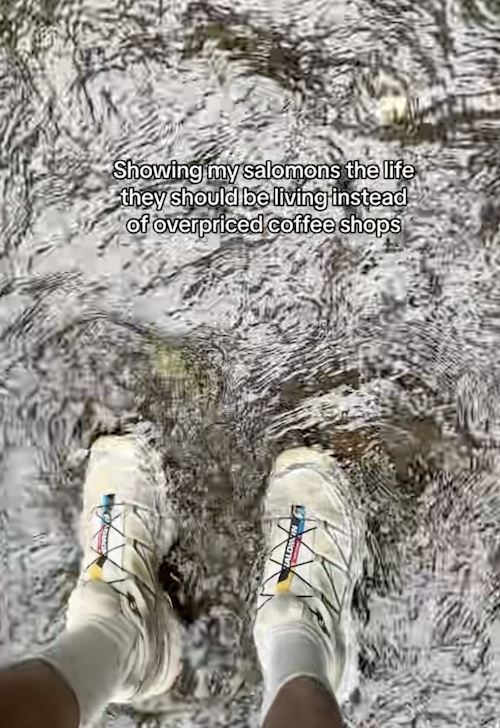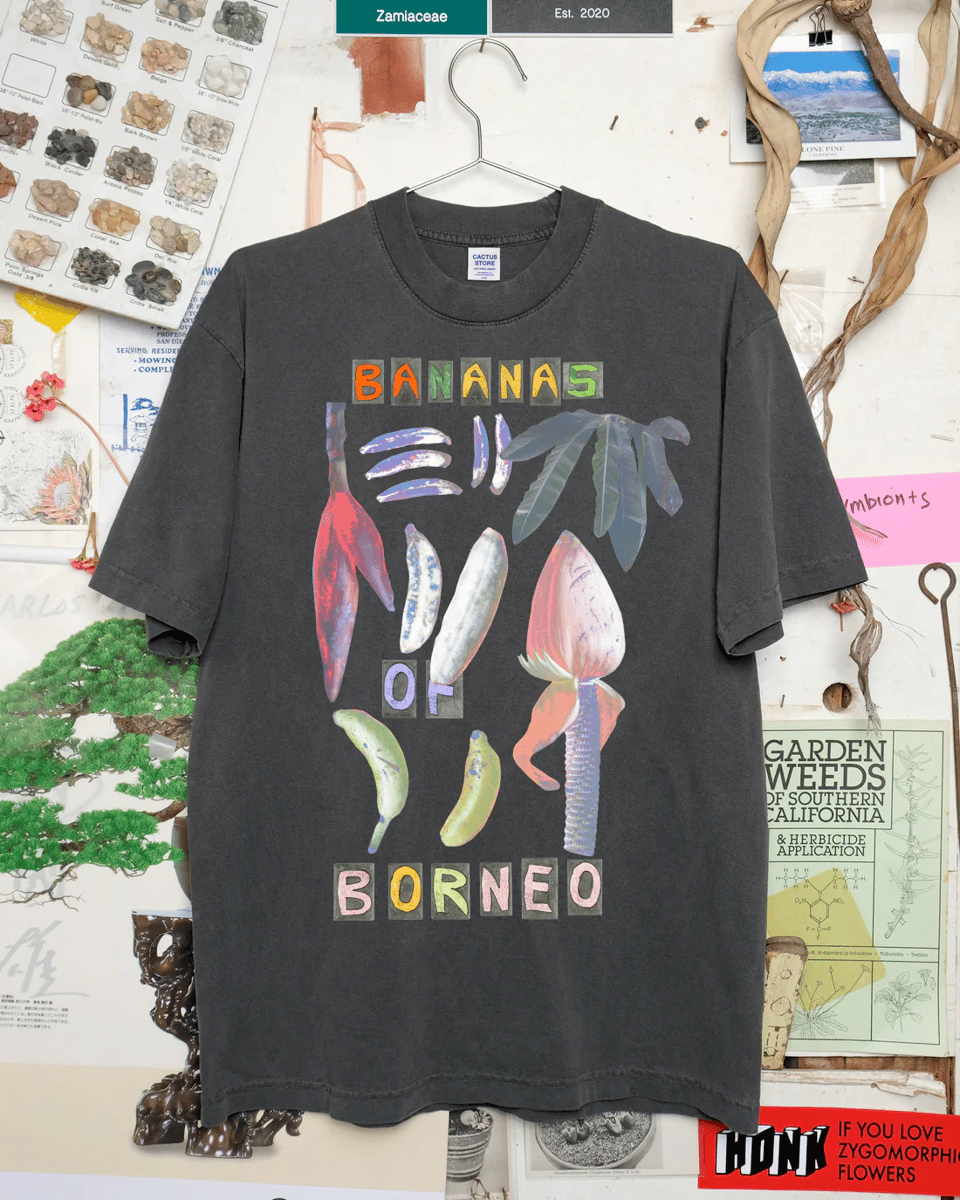I love clothing! I've always been very picky about what I wear, and in high school I got the "self-edge" denim bug while attending a fairly formal prep school, the combination of which made me care a lot about what I wear. Even now, I probably spend a couple hours a week looking at clothes online, though often just eBay resellers at this point.
But clothing and fashion are weird and concerning. Fashion gets pretty navel-gazing, so is it worth thinking about at all? See this Blackbird Spyplane response on that. And the clothing industry, particularly in fast fashion, is insanely wasteful. Seriously, bonkers-level wasteful. There's waste in manufacturing, slop between the manufacturers and retailers, heaps of clothes that go unpurchased, massive throw-out culture by consumers, and weird global supply chains leading to dumps of clothes and fabric scraps all over the place. These patterns have big environmental impacts.
 Image from Al-Jazeera in the Atacama Desert, Chile. Martin Bernetti/AFP.
Image from Al-Jazeera in the Atacama Desert, Chile. Martin Bernetti/AFP.
Beyond just a waste of resources, lots of clothes have "forever chemical" (PFAS/PFOA) in them, affecting people directly and by entering our waterways. Clothes leave other remnants in the environments in the form of microfibers: clothing degrades slowly as you wear them (or when they're in a landfill), turning into microfibers or microplastics, which can be quite mobile and affect ecosystem health, including us.
(To clarify: microfibers are tiny fragments of threads which can cause arrays of ecological problems as organisms swallow them. They aren't necessarily plastics, though plastic microfibers are the most ubiquitous form of microplastics. Microfibers of natural materials can still have negative effects but typically less than plastics because they decompose or can be digested. Microfibers are made by eroding fabric, which happens everywhere all the time. It's happening right now as you shuffle around and rub your undies against the chair while reading this.)
 image via
image via
The list of environmental problems from clothing unfortunately gets longer. Clothes made from synthetic materials (which I'll broadly call "plastics": nylon, rayon, polyester, acrylic, PVC, teflon, and the hordes of other boutique textiles) are made from fossil fuels and often require chemical treatment processes. Dyes, for synthetics and natural materials, can be toxic irritants and energy-intensive to produce and use. Labor rights violations are rampant. Growing cotton has been associated with depletion of water resources, land degredation, and bleach acidification of water bodies. It feels like there's a million problems associated with any piece of fabric or clothing.
I've been responding to these concerns as my own little consumer test (n=1), trying to move towards somewhat fewer clothing purchases and smarter ones. Thankfully, there are loads of initiatives trying to tackle different problems in this realm. In the spirit of Michael Pollan's recommended diet (“Eat food. Not too much. Mostly plants.”), I recommend: Buy fewer clothes, in slow fashion, mostly natural.
Step one is, of course, to make a wardrobe of a few things that are hardy and that you love. Even better if you can repair them, or get them repaired. Maybe you bought them used in the first place. Don't buy something that will go into the trash: keep it on your body and out of the environment!
Secondly, buy "slow." I'm invoking a lot here, but generally just the opposite of "fast fashion." Clothing made with intent, from where it's made, how it's made, by whom, and to where once the consumer is done with it. This can take many forms, which I'll illustrate with a few examples:
- Patagonia's Worn Wear program keeps clothing with more life in it out of the waste stream. The same initiative encourages repairing of your own clothes. I was a heavy user of their free wetsuit repairs when I had a patagonia wettie. Patagonia's not perfect, but I definitely admire how much advocacy work they do, very publicly.
- Everybody World has been chipping away at using recycled waste cotton from leftovers in clothing manufacturing to make new, great-feeling clothing. They are also quite committed to garment working conditions in Los Angeles, thereby celebrating local supply chains to minimize wasteful shipping.
- Industry of All Nations similarly is trying to vertically-integrate more to minimize lots of shipping waste. They forego toxic dyes and try to use place-native materials.
- Unbleached Apparel is explicitly fighting uses of bleaches and dyes, which can have human health and environmental toxicity impacts. They're also advocating for more use of natural fabrics which can perform well, even though plastics get all the performance hype.
- Dana Lee Brown is doing deep dives into small-scale fabrics production, focusing on environmentally regenerative sources close to her studio. She calls it "field-to-loom" clothing, focused on timeless basics and not responding to fashion hype cycles at all. Like Unbleached Apparel, she has used FoxFibre, which is an amazing feat of genetic engineering to grow colored cotton... so you don't have to dye it. It comes off the plant already colored. Amazing.
- Older Brother leans a bit more fashion-ey, but they are steadfastly focused on natural fabrics and natural dyes and a place-focused approach out of Oregon. It's an approach similar to Evan Kinori, who highlights incredible heritage natural fabrics (/dyes) and a slow-moving production process deeply rooted in dear old San Francisco.
 From Dana Lee Brown's website.
From Dana Lee Brown's website.
These examples all exhibit "slow" fashion in various ways to me, often with low waste, but many by way of being focused on natural materials (the third ingredient in my recipe). Cotton, silk, linen, hemp, and wool(s) are all in this category. The major benefit of using these materials is that they naturally degrade in the environment or can be digested by organisms, assuming they haven't been dyed with heavy metals or something nasty like that. They won't stick around in our waterways, leaching out polyester microplastics for thousands of years: they'll actually decompose.
This doesn't mean natural fibers are perfect, even if they're undyed. This is evolving research, but there is evidence that different natural fibers produce different kinds of microfibers. The tougher and longer the fibers, the less likely they are to become microfibers, basically. This sets up linen as a winner of the plant-based options, with long, tough fibers that can ultimately decompose quickly. Hemp is also a huge improvement over cotton in direct environmental impacts (see this paper) due to better carbon sequestration and lower water use, but it also has longer and tougher fibers relative to cotton, promoting less microfiber production. The exact impacts really do require detailed life-cycle assessments, like this one between cotton, hemp, and polyester, but the take-away is mostly simple: wear natural stuff, preferably linen or hemp. Cotton growing practices can be pretty nasty, but there's a lot of lobbying work done to cover it up. I would love to see a direct life-cycle comparison against wools as well (or silk, for which there seems to be little data), but in general these protein-based fibers will biodegrade with few problems. Other questions about wool and silk depend on where and how they were produced—ask your local shepherd or sericulturist.
The last thing I'd like to highlight here is clothing as a vector for awareness of environmental problems. The alignment of a cultural boom in healthy living, COVID-fueled outdoor recreation, and the 20-year cultural cycle regurgitating y2k-era gorpcore ("good 'ol raisins & peanuts"—slang for hiking/outdoorsey) has created a pretty big ecosystem of outdoor-oriented or environmentally-inspired clothing.

Whether this is "good" or "bad" requires loads more research. It might mean more PFAS-loaded raincoats and plastic doodads, but it might also mean a distributed campaign for millions more people to develop deeper senses of care for their environments and awareness of their consumption impacts. Some of the brands are working hard to make it cool to care for the environment, and some of them take their environmental impacts seriously too, to boot. I'm talking about projects like the Usal Project, which organizes outings for people, connecting land experts with folks who maybe just wanted to buy a tee-shirt. This model of taking the power of cultural cool and leveraging it into some environmental action has long been part of the model at Cactus Store: where else could we find a shirt where 50% of proceeds support banana biodiversity research?

The approaches to gorpcore range from genuine environmental care to absolute greenwashing, and I'm only just starting to learn more about the European context (hello Houdini?). When you're buying, keep an eye out for how, exactly, what you're buying is trying to use less land, less water, fewer petrochemicals, with biodegradable materials, and make their gear last longer. I also don't want to completely cancel plastics: they can have absolutely incredible attributes in conditions where performance is crucial or where hardiness really pays off. (My wetsuits are all made of petroleum.) But it's worth double-checking what you could swap for something natural (like waxed canvas for waterproofing), something PFAS-free, or something where merino-nylon-lycra mixes just perform really well.
Naturally-dyed,
Lukas
P.S. I have been on an extended sidequest trying to find affordable, non-plastic pants with gusseted crotch construction. (I bike a lot and blow out pants if they don't have it.) The standard has become my Gramicci pants, in organic cotton but I would love to find more if you have recommendations. Vancouver-based Haven makes most of their in-house brand pants with gussets, but they are high price point; I found one pair secondhand. Earth\Studies also has nice pants but they're too similar to Gramicci to justify the high price, to me, and they have some detailing I don't love. Service Works trousers seem mostly gusseted, in organic cotton, but I have yet to try some. Rivendell and Outlier both make some nice pants for biking but they're all made of plastic. (Remember when Outlier.cc was cycling-focused? I miss that era. Rivendell is staying true, and producing locally.)
P.P.S. I have also noticed a minor trend of "clothing for gardening" being in-vogue. It tends to be breathable, looser, and with lots of pockets. I call this GARDENINGCORE. Whatever brings out your green thumb...
P.P.S. Here's a reminder that you can sign up for a premium/paid subscription of my newsletter if you really like it or want to support it. You can edit your subscription via the signup page!
You just read issue #97 of Gnamma. You can also browse the full archives of this newsletter.